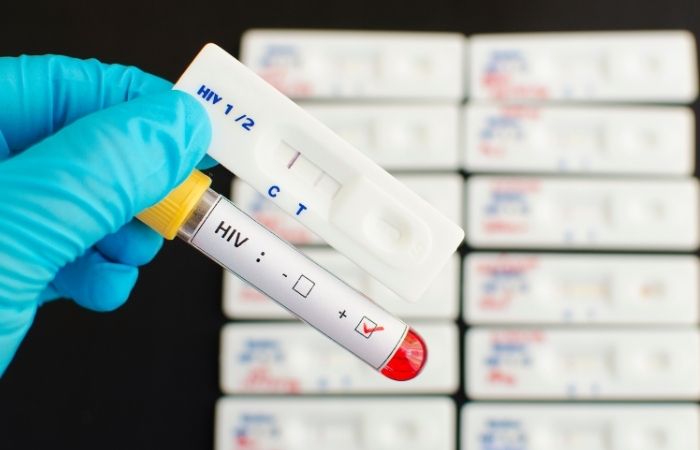Quick Answer: A bump that looks like a pimple could actually be herpes or HPV. Herpes blisters often sting, cluster, or crust over. Warts from HPV may look flesh-toned and rough. If a bump doesn’t heal in a few days, it’s time to test.
This Isn’t Just Razor Burn, And Here’s Why
There’s a reason “STD bump or pimple” gets searched nearly 15,000 times every month. It’s one of the most common, most anxiety-soaked rabbit holes people fall into at 2AM. The truth? Skin conditions on the genitals are confusing as hell, and most people are never taught the difference between a shaving nick and a viral blister.
Herpes (HSV) and HPV warts often disguise themselves as mundane. They show up on the outside, on labia, scrotum, thighs, even inner buttocks, where shaving, friction, or sweat also cause irritation. Many herpes blisters start as what look like pimples: red bumps, maybe with a white center, maybe just a little tender. But unlike a pimple, they don’t just “pop and disappear.” They linger. They spread. They morph into tiny ulcers. And they hurt in a way that’s hard to ignore.
According to the CDC, over half of American adults carry HSV-1 or HSV-2, even though most will never be diagnosed. Herpes is that common, and that misidentified. In fact, one peer-reviewed study found that patients misidentified herpes symptoms 71% of the time, mistaking them for shaving irritation, ingrown hairs, or allergic reactions.
And then there’s HPV, just as tricky. Genital warts can look like skin tags, tiny nubs, or nothing at all. They're usually painless and often go unnoticed until they’re spotted during a Pap smear or STI screening. They don’t hurt, they don’t ooze, but they spread quietly, and they stick around. According to the World Health Organization, HPV is the most common STI in the world, affecting nearly all sexually active people at some point.
Real People, Real Bumps, Real Regret
Jay, 27, had been shaving for years without a problem. So when he noticed a painful blister near his groin, he assumed it was a clogged pore or folliculitis. “I didn’t think twice,” he told us. “I popped it like I would a zit. It crusted over a few days later, but then more showed up.” By the time he saw a doctor, the herpes outbreak had fully developed, and the delay meant longer healing, more discomfort, and a painful phone call to the last person he’d slept with.
“I was so embarrassed. I kept thinking, if I had just Googled it and gotten tested, I could have handled this way sooner.”
His story isn’t rare. In fact, in a study from BMC Family Practice, general practitioners noted that patients often presented with HSV only after multiple mistaken assumptions, including heat rash, bug bites, and eczema. One physician even shared that a patient believed their blisters were caused by “cheap detergent.” The denial isn’t stupidity, it’s survival. Because the shame around STDs is so baked in, people convince themselves of any alternative rather than say the word “herpes” out loud.
We need to talk about that. Not just for Jay, or for the hundreds of anonymous searchers typing “razor burn or STD” into Google tonight, but for all of us who’ve been taught that STI symptoms are dirty, obvious, or punishable. Because none of that is true.

People are also reading: How Chlamydia Increases Your Risk of HIV
Herpes, HPV, and the Pimple That Isn’t
Let’s zoom in. Literally.
Herpes lesions start small, tiny red or clear blisters that may cluster or appear solo. They often sting, itch, or pulse. Some burst and become shallow ulcers before crusting over. Others just scab without popping. The first outbreak is usually the worst, sometimes accompanied by fever, body aches, or swollen lymph nodes. Recurrent outbreaks are milder, but they still follow a pattern: tingle, blister, scab, heal. If that bump you’re watching does any of those things, it’s time to test.
HPV warts, on the other hand, don't tingle or crust. They don’t ooze or scab. They just... exist. Flesh-colored or pale pink, soft or bumpy, sometimes smooth, sometimes cauliflower-shaped. They're stubborn, and they multiply. They rarely itch, but friction can make them bleed. If your “razor bump” has stuck around for weeks without change, or started spreading, it's probably not a razor bump.
And yes, sometimes it really is just a pimple. But even that deserves a second look if it’s painful, pus-filled, and refuses to heal after a few days. Pimples don’t come with flu symptoms. Pimples don’t spread across your vulva or shaft. Pimples don’t come back in the exact same spot every few months. Herpes does. HPV does. It’s not about fear, it’s about facts.
Why You Didn’t Know, And Why That’s Not Your Fault
There’s a reason so many people mistake herpes for razor burn, or confuse genital warts with harmless skin tags. No one taught us what STDs actually look like. Not in school. Not in doctor’s offices. Definitely not in sex ed, if you were even lucky enough to get that.
Instead, we get fear-based posters, pixelated stock photos, or shame-riddled lectures about “promiscuity.” We’re told condoms fix everything, or that you’ll “just know” if something’s wrong. But herpes and HPV don’t always announce themselves with drama. They whisper. They itch. They linger. They trick you into thinking you're overreacting. And because we’re conditioned to feel dirty for asking questions, we stay silent instead of getting tested.
One study in the *Sexually Transmitted Diseases* journal showed that over 60% of people with herpes didn’t know they had it. Not because they weren’t careful. Not because they were irresponsible. But because the symptoms were subtle, intermittent, or mistaken for something else. HPV is even sneakier, most people will never feel a thing. It’s often caught during a Pap smear or diagnosed after transmission has already occurred.
Stigma is a public health crisis. It delays testing, treatment, and conversations. It makes people feel like they deserve their symptoms. It convinces partners to lie, patients to avoid care, and searchers to keep scrolling rather than click “book appointment.” And it keeps herpes and HPV spreading, not because people are careless, but because they’re scared.
Check Your STD Status in Minutes
Test at Home with Remedium6-in-1 STD Test Kit

 For Men & Women
For Men & Women Results in Minutes
Results in Minutes No Lab Needed
No Lab Needed Private & Discreet
Private & DiscreetOrder Now $119.00 $294.00
For all 6 tests
The Myths That Make You Wait Too Long
Let’s break a few of these down. If any of these sound familiar, you’re not alone, and you’re not wrong for thinking them.
“It can’t be an STD if I used a condom.” Yes, it can. HSV and HPV are skin-to-skin transmitted infections. That means contact with the surrounding area, thighs, labia, pubic hair, even the base of the penis, can pass the virus, even if penetration never happened.
“I didn’t feel anything during sex, so I’m probably fine.” Another trap. Many first outbreaks appear days or even weeks after exposure. Sometimes symptoms don’t show up for months, or ever. That’s how these viruses survive: by staying quiet long enough for you to pass them on unknowingly.
“I’m clean, I got tested after my last partner.” This one stings, but needs saying: most standard STI panels don’t include herpes unless you ask. HPV screening is usually only done via Pap tests or anal swabs, depending on your anatomy. So unless your test results say specifically that you were screened for HSV and HPV, there’s a chance you weren’t.
We need to stop judging these misunderstandings and start making room for them. You aren't dumb. You're trying to make your way through a broken system that values fear over clarity. Let's change the story.
Testing Isn’t Just for "Other People"
Testing doesn’t mean you did something wrong. It means you’re paying attention. You’re tuning in. You’re making decisions based on truth, not shame. And whether that truth comes back “negative” or not, it’s yours to own, understand, and move forward with.
Herpes and HPV are lifelong infections, but they are not life-ending, and they are absolutely manageable. There’s no cure for either, but there are antivirals that suppress herpes symptoms and reduce transmission risk. There are vaccines that protect against HPV. There are topical treatments that shrink or remove warts. And more importantly, there are entire communities, partners, therapists, forums, healthcare providers, who will meet you in this space with zero judgment and a whole lot of compassion.
Testing can happen from home now. Discreetly. Privately. No waiting rooms. No awkward conversations with strangers. Just a small kit, a few swabs or drops of blood, and a lab report that gives you answers, real ones.
If you’re staring down a bump that won’t go away, a blister that doesn’t behave like a pimple, or just a gut feeling that something’s not right, there’s no harm in checking. But there can be harm in waiting. Not just physically, but emotionally. Because sitting in that uncertainty can eat away at you.
This combo STD test kit checks for herpes, chlamydia, gonorrhea, and more. It’s lab-certified, FDA-cleared, and designed for people who need clarity without chaos. Whether it’s herpes, HPV, or just a stubborn ingrown hair, you deserve to know.

People are also reading: Can Gonorrhea Cause Infertility in Men?
Your Body, Your Sex Life, Your Rules, Even After a Diagnosis
If it is herpes, or HPV, or something else entirely, you are still you. You are still worthy of touch, pleasure, intimacy, and love. An STI doesn’t strip away your desirability or your future. It just gives you a new lens through which to care for yourself and others.
Let’s kill another myth: getting herpes doesn’t mean someone cheated, or that you were reckless. It means you’re human. It means your body came into contact with another body, and something microscopic passed between you. That’s not a moral failing. That’s how skin works. That’s how sex works.
One of the most powerful shifts people experience after a diagnosis is how they talk about sex. Suddenly, you’re more informed. You learn about windows of contagiousness, how suppression therapy works, how barriers and honesty matter. You begin having conversations with potential partners not just about status, but about preferences, pleasure, communication. It’s intimate in a whole new way. Not less sexy, more.
And yes, disclosure is scary. But it’s also an incredible filter. The people who back away? They're telling you they're not ready for nuance. The ones who stay? They’re choosing you, not a perfect record. Herpes is not a dating death sentence. HPV is not a wall between you and future partners. These infections may shift your sex life, but often, they make it deeper, clearer, and more consensual than ever before.
Check Your STD Status in Minutes
Test at Home with Remedium10-in-1 STD Test Kit

 For Women
For Women Results in Minutes
Results in Minutes No Lab Needed
No Lab Needed Private & Discreet
Private & DiscreetOrder Now $189.00 $490.00
For all 10 tests
So What Now? Here’s What You Can Actually Do
Start by listening to your body. That bump? Watch it, but don’t wait forever. If it hasn’t changed in 5–7 days, or if it’s spreading, crusting, itching, or stinging, it’s time to test. You can talk to a doctor, go to a local clinic, or order a test kit online and handle it from your bathroom. What matters is that you don’t ignore it.
If you test positive for herpes, a provider can prescribe antivirals like valacyclovir or acyclovir. These help shorten outbreaks and reduce the chance of passing the virus on. You’ll learn your own body’s rhythms, what triggers flare-ups (stress, friction, menstruation), and how to manage them.
If it’s HPV, treatment may involve topical medications, cryotherapy, or electrosurgical removal. Some strains of HPV carry a higher risk of cervical or anal cancer, which is why routine screening (like Pap smears or high-risk HPV tests) matters, especially if you have a cervix or engage in anal sex. If you’re under 45 and haven’t gotten the HPV vaccine, you still might be eligible. It’s worth asking.
And if it’s nothing, just a pimple, an ingrown hair, a rogue shaving reaction, then you walk away with peace of mind. That alone is worth it. Anxiety steals sleep, energy, and confidence. Knowing what’s going on with your body gives all of that back.
Whatever the result, testing isn't the end. It's a beginning. A beginning of care, communication, and clarity. It lets you decide what happens next. It brings you back into power.
STD Rapid Test Kits is here to make that easier. No shame. No delay. Just real answers from real labs, delivered straight to your door.
FAQs
1. Is it possible for herpes to look like a pimple?
Yes. A lot of the time, herpes starts out as little red or white bumps that look like pimples or ingrown hairs. The main difference is that herpes blisters hurt, group together, or turn into ulcers before they scab over.
2. How can I tell if it's an STD or just a burn from shaving?
Razor burn usually goes away in a few days and doesn't spread or cause blisters. If the bump stays there, hurts, itches a lot, or comes back in the same spot, you should get tested for STDs.
3. Is it possible to get herpes or HPV without having sex?
Yes. Both viruses can be passed from one person to another through skin-to-skin contact. This means that oral sex, genital grinding, or even non-penetrative foreplay can spread them.
4. Do herpes or HPV always have signs?
No. A lot of people have herpes or HPV but don't show any signs of it. Some people only find out they have it when they get tested or when they give it to a partner without meaning to.
5. Can you pop a herpes sore?
You shouldn't. Popping can move the virus to other parts of your body and make you more likely to get a secondary infection. Let blisters heal on their own or with antiviral medicine.
6. How long do herpes outbreaks last?
The first outbreak could last anywhere from two to four weeks. After the first outbreak, the next ones are usually shorter, lasting 7 to 10 days, if the right antiviral treatment is given.
7. Is it okay to have sex if I have herpes or HPV?
Yes. You can have a full and enjoyable sex life if you get an education, take antiviral medicine, use condoms or dental dams, and talk to your partner.
8. Is there a way to get rid of herpes or HPV?
Not right now. Both are possible to deal with with medical help. Over time, HPV usually goes away on its own, but you can keep herpes under control by taking medicine every day.
9. Are STD tests you do at home accurate?
Yes. STD Rapid Test Kits are a good example of a reputable test kit that uses lab-validated methods to accurately screen for common STIs like herpes, chlamydia, gonorrhea, and HIV.
10. If I test positive, should I tell my partner?
Yes, morally. Sharing information with your partner helps them make smart choices and builds trust. A lot of partners respond with kindness and interest, not judgment.
You Deserve Answers, Not Assumptions
It's easy to ignore a bump, especially if you're busy, stressed, or scared of what it might mean. But the only way to get your power back is to push through the fear. The truth sets you free, no matter if you have herpes, HPV, or something else that isn't serious. Without worry, without shame, and able to move forward with care and clarity.
Don't wait and wonder; get the answers you need. This at-home combo test kit quickly and discreetly checks for the most common STDs.
Sources
1. CDC: About Genital Herpes (Fact Sheet)
2. CDC: STI Treatment Guidelines for Herpes
3. CDC: HSV‑1 and HSV‑2 Prevalence Data (NHANES, 2015‑2016)










